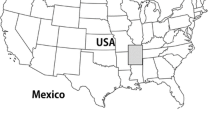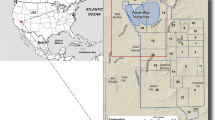Abstract
The Memphis aquifer in southwestern Tennessee is a confined to semi-confined unconsolidated sand aquifer and is the primary municipal water source for the Memphis metropolitan area. Leakage of modern water from shallow unconfined aquifers through the upper Claiborne confining unit locally degrades water quality in the Memphis aquifer and makes the aquifer more vulnerable to contamination. Major solute chemistry, tritium, and 3H/3He data were used to investigate the source and mixing proportions of modern water in the Memphis aquifer in the Davis well field, Memphis, Tennessee. Water quality in several production wells in the Davis well field has declined over the past 30 years, mainly through increased total dissolved solids, iron, alkalinity, and hardness. Trends in chemical data, tritium, and other hydrogeologic data support a source for the leakage from the Mississippi River Valley Alluvial aquifer. Mixing proportions of alluvial water in production well water obtained by inverse chemical modeling with PHREEQCi range from 7 to 45%. For two of the production wells, MLGW 414 and 432, 3H/3He data yield mixing ratios similar to those obtained from PHREEQCi in three of four cases; the dissimilar ratio is likely due to a poor solution from the PHREEQCi inverse modeling. Modeling of the age distribution obtained from MLGW 414 and 432 using an exponential-piston flow model (EPM) with an inverse solution computer code yielded mixed results. The EPM solution obtained for MLGW 414 converged with difficulty only for a 5-year transit time in the shallow aquifer and is consistent with a source from the Mississippi River Valley Alluvial aquifer; however, the modeled age of the water is greater than that observed. In comparison, the EPM solution for MLGW 432 converged for the 5- and 7-year transit periods in the shallow aquifer and yielded model ages consistent with observed 3H/3He ages; however, the extent of the maximum radii for infiltration source is not consistent with a Mississippi River Valley Alluvial aquifer source. Other potential sources for leakage to MLGW 432 include water from the Fluvial-terrace aquifer migrating along a fault east of the well field or infiltration of water from a lake south of the well field.













Similar content being viewed by others
References
Ackerman DJ (1996) Hydrology of the Mississippi River Valley Alluvial aquifer, south-central United States. US Geological Survey Professional Paper 1416-D
Arthur JK (2001) Hydrogeology, model description, and flow analysis of the Mississippi River Alluvial aquifer in northwestern Mississippi. US Geological Survey Water-Resources Investigations Report 01-4035
Back W (1986) Role of aquitards in hydrogeochemical systems: a synopsis. Appl Geochem 1:427–437
Bayer R, Schlosser P, Bonisch G, Rupp H, Zaucker F, Zimmek G (1989) Performance and blank components of a mass spectrometric system for routine measurements of helium isotopes and tritium by the 3He in-growth method. Sitzungsberichte der Heidelberger Akademie der Wissenschaften, Mathematisch-naturwissenschaftliche Klasse 5:241–279
Bradley MW (1991) Ground-water hydrology and the effects of vertical leakage and leachate migration on ground-water quality near the Shelby County landfill, Memphis, Tennessee. US Geological Survey Water-Resources Investigations Report 90-4075
Brahana JV, Broshears RE (2001) Hydrogeology and ground-water flow in the Memphis and Fort Pillow aquifers in the Memphis area, Tennessee. US Geological Survey Water Resources Investigation 89-4131
Bredehoeft JD, Neuzil CE, Milly PCD (1983) Regional flow in the Dakota aquifer: A study of the role of confining layers. US Geological Survey Water-Supply Paper 2237
Brown MC (1993) A study of the aquifer system at the Davis well field. MS Thesis Memphis State University 163 pp
Carmichael JK, Parks WS, Kingsbury JA, Ladd DE (1997) Hydrogeology and ground-water quality at Naval Support Activity Memphis, Millington, Tennessee. US Geological Survey Water Resources Investigation 97-4158
Clark I, Fritz P (1997) Environmental isotopes in hydrogeology. CRC Press, Boca Raton, p 343
Clarke WB, Jenkins WJ, Top Z (1976) Determination of tritium by mass spectrometric measurements of 3He. Int J Appl Radiat Isot 27:515–522
Cook PG, Böhlke JK (2000) Determining timescales of groundwater flow and solute transport: In: Cook PG, Herczeg AL (eds) Environmental tracers in subsurface hydrology. Kluwer, Boston, pp 1–30
Corcho-Alvarado JA, Purtschert R, Barbecot F, Chabault C, Rueedi J, Schneider V, Aeschbach-Hertig W, Kipfer R Loosli H H (2007) Constraining the age distribution of highly mixed groundwater using 39Ar; a multiple environmental tracer (3H/3He, 85Kr, 39Ar, and 14C) study in the semiconfined Fontainebleau Sands Aquifer (France). Water Resour Res 43. doi:10.1029/2006WR005096
Criner JH, Armstrong CA (1958) Ground-water supply of the Memphis area. US Geological Survey Circular 408
Criner JH, Parks WS (1976) Historic water-level changes and pumpage from the principal aquifers of the Memphis area, Tennessee: 1886–1975. US Geological Survey Water Resources Investigation, pp 76–67
Criner JH, Sun P-CP, Nyman DJ (1964) Hydrology of the aquifer systems in the Memphis area, Tennessee. US Geological Survey Water-Supply Paper 1779-O
Cross B (1989) Tritium deposition data-access program. DEP.BAS. U.S. Geological Survey, Reston
EPA (1993) Guidelines for delineation of wellhead protection areas. EPA-440/5-93-001, Washington
Fortin G, van der Kamp G, Cherry JA (1991) Hydrogeology and hydrochemistry of an aquifer-aquitard system within glacial deposits, Saskatchewan, Canada. J Hydrol 126:265–292
Gentry RW, Ku T-L, Luo S, Todd V, Larsen D, McCarthy J (2005) Resolving aquifer behavior near a focused recharge feature based upon synoptic wellfield hydrogeochemical tracer results. J Hydrol 323:387–403
Gentry R, McKay L, Thonnard N, Anderson JL, Larsen D, Carmichael JK, Soloman K (2006) Novel techniques for investigating recharge to the Memphis aquifer. AWWARF Report 91137, American Water Works Association, Denver, Colorado, 97 pp
Graham DD, Parks WS (1986) Potential for leakage among principal aquifers in the Memphis area, Tennessee. US Geological Survey Water-Resources Investigations Report 85-4295
Grubb HF (1998) Summary of hydrology of the regional aquifer systems, Gulf Coastal Plain, south-central United States. US Geological Survey Professional Paper 1416-A
Hosman RL, Long AT, Lambert TW, Jeffery HG (1968) Tertiary aquifers in the Mississippi embayment. US Geological Survey Professional Paper 448-D
Hunt AG, Christenson SC, Parkhurst DL (2008) Use of atmospherically derived dissolved gases and tritium tp characterize ground-water flow in the Arbuckle-Simpson aquifer. Geological Society of America, abstracts with Programs 40:6:122
Ivey SS, Gentry R, Larsen D, Anderson J (2008a) Theoretical study of the inverse application of age distribution modeling using 3H/3He. J Hydraul Eng 13:1002–1010
Ivey SS, Gentry R, Larsen D, Anderson J (2008b) Case study of the inverse application of age distribution modeling using 3H/3He: MLGW Sheahan Wellfield, Memphis, TN. J Hydraul Eng 13:1011–1020
Katz BG, McBride WS, Hunt AG, Crandall CA, Metz PA, Eberts SM, Berndt (2009) Vulnerability of a public supply well in a karst aquifer to contamination. Ground Water 47:438–452
Kingsbury JA (1996) Altitude of the potentiometric surfaces, September 1995, and historical water-level changes in the Memphis and Fort Pillow aquifers in the Memphis area, Tennessee. US Geological Survey Water Resources Investigation 96-4278
Koban JM Jr (2008) Leakage and potential contaminant migration into the Memphis aquifer at Davis well field in Shelby County, Tennessee. Master’s Thesis University of Memphis, 86 pp
Krinitsky EL (1949) Geological investigation of gravel deposits in the Lower Mississippi Valley and adjacent uplands. US Army Corps of Engineers Waterways Experiment Station Technical Memorandum. Vicksburg, Mississippi, USA, pp 3–272
Landon MK, Clark BR, McMahon PB, McGuire VL, Turco MJ (2009) Hydrogeology, chemical characteristics, and transport processes in the zone of a public-supply well in York, Nebraska. US Geological Survey Scientific Investigations Report 2008-5050
Larsen D, Gentry RW, Solomon DK (2003) The geochemistry and mixing of leakage in a semi-confined aquifer at a municipal well field, Memphis, Tennessee, USA. Appl Geochem 18:1043–1063
Larsen D, Waldron B, Anderson JL, Gentry RW, Ivey S, Koban J, Morat J, Owen A (2007) Noble gas and tritium—helium-3 data from municipal well fields in Shelby county, Tennessee, USA: implications for groundwater recharge processes to the Memphis aquifer through windows in the upper Claiborne confining unit. Geological Society of America, Abstracts with Programs, 39:2:76
Manning AH, Solomon DK, Thiros SA (2005) 3H/3He age data in assessing the susceptibility of wells to contamination. Ground Water 43:353–367
McClure DM (1999) The distribution, stratigraphic characteristics and origin of late Cenozoic alluvial deposits in Shelby County, Tennessee. Masters Thesis University of Memphis, 112 pp
McMahon PB (2001) Aquifer/aquitard interfaces: mixing zones that enhance biogeochemical reactions. Hydrogeol J. doi:10.1007/s100400000109
Mirecki JE, Parks WS (1994) Leachate geochemistry at a municipal landfill, Memphis, Tennessee. Ground Water 32:390–398
Moore GK, Brown DL (1969) Stratigraphy of the Fort Pillow test well, Lauderdale County, Tennessee. Tennessee Division of Geology, Report of Investigations 26, Nashville, Tenneessee
Nyman DJ (1965) Predicted hydrologic effects of pumping from the Lichterman well field in the Memphis area, Tennessee. US Geological Survey Water-Supply Paper 1819-B
Parks WS (1990) Hydrogeology and preliminary assessment of the potential for contamination of the Memphis aquifer in the Memphis area, Tennessee. US Geological Survey Water-Resources Investigations Report 90-4092
Parks WS, Carmichael JK (1990) Geology and ground-water resources of the Memphis Sand in western Tennessee. U.S. Geological Survey Water-Resources Investigations Report 88-4182
Parks WS, Mirecki JE (1992) Hydrogeology, ground-water quality and potential for water-supply contamination near the Shelby County landfill in Memphis, Tennessee. US Geological Survey Water-Resources Investigations Report 91-4173
Parks WS, Mirecki JE, Kingsbury JA (1995) Hydrogeology, ground-water quality, and source of ground water causing water-quality changes in the Davis well field at Memphis, Tennessee. US Geological Survey Water-Resources Investigations Report 94-4212
Plummer LN, Bexfield LM, Anderhom SK, Sanford WE, Busenberg E (2008) Use of chemical and isotopic data to improve conceptualization of groundwater flow; lessons from the middle Rio Grande Basin, NM. Geological Society of America, Abstracts with Programs, 40:6:120
Pucci AA, Ehlke TA, Owens JP (1992) Confining unit effects on water quality in the New Jersey Coastal Plain. Ground Water 30:415–427
Richardson GJ (1989) A study of potential sources of leakage into the Memphis Sand aquifer beneath the Davis well field in Memphis, Tennessee. Masters Thesis Memphis State University, 82 pp
Robinson JL, Carmichael JK, Halford KJ, Ladd DE (1997) Hydrogeologic framework and simulation of ground-water flow and travel time in the shallow aquifer system in the area of Naval Support Activity Memphis, Millington, Tennessee. US Geological Survey Water-Resources Investigations Report 97-4228
Saucier RT (1987) Geomorphological interpretation of Late Quaternary in western Tennessee and their regional tectonic implications. US Geological Survey Professional Paper 1336-A
Solomon DK, Cook PG (2000) 3H and 3He. In: Cook PG, Herczeg AL (eds) Environmental tracers in subsurface hydrology. Kluwer, Boston, pp 397–424
Stevens KC (2007) A structural interpretation of near-surface borehole data in Shelby County, Tennessee. Master’s Thesis University of Memphis, 60 pp
Van Arsdale RB, Bresnahan RP, McCallister NS, Waldron B (2008) The Upland Complex of the central Mississippi River valley: its origin, denudation, and possible role in reactivation of the New Madrid seismic zone. In: Stein S, Mazzotti S (eds) Continental intraplate earthquakes: Science, hazard, and policy issues. Geological Society of America Special Paper 425, pp 177–192
Webbers A (2003) Public water-supply systems and associated water use in Tennessee, 2000. US Geological Survey Water-Resources investigations Report 03-4264
Wicks CM, Herman JS (1994) The effect of a confining unit on the geochemical evolution of ground water in the Upper Floridan aquifer system. J Hydrol 153:139–155
Zuber A (1986) Mathematical models for the interpretation of environmental radioisotopes in groundwater systems. Handbook of environmental isotope geochemistry. Elsevier, Amsterdam, pp 1–59
Acknowledgments
This research was funded by a grant from the Shelby County Health Department and contributions from the Ground Water Institute. We appreciate the assistance of Memphis, Light, Gas, and Water for access to the wells, especially Bobbie Felton, Bubba Vick, and Harold Smith for controlling well operation, maintaining pressurization in the wells, and ensuring stable conditions for our sampling efforts.
Author information
Authors and Affiliations
Corresponding author
Rights and permissions
About this article
Cite this article
Koban, J., Larsen, D. & Ivey, S. Resolving the source and mixing proportions of modern leakage to the Memphis aquifer in a municipal well field using geochemical and 3H/3He data, Memphis, Tennessee, USA. Environ Earth Sci 66, 295–310 (2012). https://doi.org/10.1007/s12665-011-1239-x
Received:
Accepted:
Published:
Issue Date:
DOI: https://doi.org/10.1007/s12665-011-1239-x




